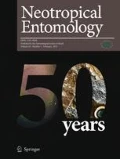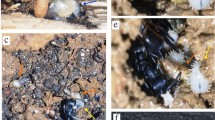Abstract
Leaf-cutting ants have long been recognized to forage via complex trail systems but the nature and the ecological drivers of the different foraging strategies adopted remain a key topic. Here, we described the spatiotemporal use of belowground foraging galleries by Atta sexdens L. in the Brazilian Atlantic forest, and examined the adaptive advantages of this foraging strategy. Protium heptaphyllum adult trees (DBH > 10 cm), seed/seedling clumps and ant gallery entrances were mapped across two 1-ha plots during two consecutive fruiting seasons (2002 and 2004). We recorded 75 ca. 40 cm deep gallery entrances beneath 26 P. heptaphyllum trees at nest distances ranging from 14 to 57 m. Furthermore, gallery abundance and galleries associated with seed/seedling clumps correlated positively with P. heptaphyllum density. Our results indicate that A. sexdens was able to set a permanent system of underground galleries targeting P. heptaphyllum trees and their seeds on the ground. Such network of galleries was spatially arranged according to both the spatial distribution and abundance of P. heptaphyllum trees in a way that most gallery entrances were disposed beneath or in close periphery of P. heptaphyllum crowns. Our findings suggest that underground trail systems shaped by fruit resources represent a foraging strategy clearly more common than existing literature on the subject would suggest. In addition, it reinforces the notion that the spatiotemporal availability of resources combined with predation risk largely influence trail configurations as well as overall foraging strategies adopted by leaf-cutting ants.


Similar content being viewed by others
References
Cherrett JM, Peregrine DJ (1976) A review of the status of leaf-cutting ants and their control. Ann App Biol 84:124–133
Corrêa MM, Bieber AGD, Wirth R, Leal IR (2005) Occurrence of Atta cephalotes (L.) (Hymenoptera: Formicidae) in Alagoas, Northeastern Brazil. Neotrop Entomol 34:695–698
Coutinho RQ, Lima Filho MF, Souza Neto JB, Silva EP (1998) Características climáticas, geológicas, geomorfológicas e geotécnicas da Reserva Ecológica de Dois Irmãos. In: Machado IC, Lopes AV, Pôrto KC (eds) Reserva Ecológica de Dois Irmãos: estudos em um remanescente de mata Atlântica em área urbana. Editora Universitária da UFPE, Recife, pp 21–49
Dalling JW, Wirth R (1998) Dispersal of Miconia argentea seeds by leaf-cutting ant Atta colombica. J Trop Ecol 14:705–710
Dohm C, Leal IR, Tabarelli M, Meyer ST, Wirth R (2011) Leaf-cutting ants proliferate in the Amazon: an expected response to forest fragmentation? J Trop Ecol 27:645–649
Falcão PF, Pinto SRR, Wirth R, Leal IR (2011) Edge-induced narrowing of dietary diversity in leaf-cutting ants. Bull Entomol Res 101:305–311
Farji-Brener AG, Silva J (1996) Leaf-cutter ants’ (Atta laevigata) aid to the establishment success of Tapirira velutinifolia (Anacardiaceae) seedlings in a parkland savanna? J Trop Ecol 12:163–168
Fowler HG, Stiles EW (1980) Conservative resource management by leaf-cutting ants? The role of foraging territories and trails, and environmental patchiness. Sociobiology 5:25–41
Fowler HG, Pagani MI, Silva OA, Forti LC, Saes NB (1989) A pest is a pest is a pest? The dilemma of neotropical leaf-cutting ants: keystone taxa of natural ecosystems. Environ Manage 13:671–675
Fowler HG, Schlindwein MN, Schlittler FM, Forti LC (1993) A simple method for determining location of foraging ant nests using leaf-cutting ants as a model. J Appl Entomol 116:420–422
Kost C, Oliveira EG, Knoch TA, Wirth R (2005) Spatio-temporal permanence and plasticity of foraging trails in young and mature leaf-cutting ant colonies (Atta spp.). J Trop Ecol 21:677–688
Leal IR, Oliveira PS (1998) Interactions between fungus-growing ants (Attini), fruits and seeds in cerrado vegetation in Southeast Brazil. Biotropica 30:170–178
Leigh EG Jr, Wright SJ, Herre EA (1993) The decline of tree diversity on newly isolated tropical islands: a test of anull hyphotesis and some implications. Evol Ecol 7:76–102
López F, Acosta FJ, Serrano JM (1993) Responses of the trunk routes of a harvester ant to plant density. Oecologia 93:109–113
Meyer ST, Leal IR, Wirth R (2009) Persisting hyper-abundance of keystone herbivores (Atta spp.) at the edge of an old Brazilian Atlantic Forest fragment. Biotropica 41:711–716
Mintzer A (1979) Foraging activity of the mexican leaf-cutting ant Atta mexicana (F Smith), in a Sonoran desert habitat (Hymenoptera, Formicidae). Insect Soc 26:364–372
Moreira AA, Forti LC, Boaretto MAC, Andrade APP, Rossi MN (2003) Substrate distribution in fungus chambers in nests of Atta bisphaerica Forel, 1908 (Hym., Formicidae). J Appl Entomol 127:96–98
Moser JC (2006) Complete excavation and mapping of a Texas leaf cutting ant nest. Ann Entomol Soc Am 99:891–897
Pyke G (1984) Optimal foraging theory: a critical review. Annu Rev Ecol Syst 15:523–575
Shepherd JD (1982) Trunk trails and the searching strategy of a leaf-cutter ant, Atta colombica. Behav Ecol Sociobiol 11:77–84
Shepherd JD (1985) Adjusting foraging effort to resources in adjacent colonies of the leaf-cutting ant, Atta colombica. Biotropica 17:245–252
Silva JMC, Tabarelli M (2000) Tree species impoverishment and the future flora of the Atlantic forest of northeast Brazil. Nature 404:72–74
Silva PD, Leal IR, Wirth R, Tabarelli M (2007) Harvesting of Protium heptaphyllum (Aubl.) March. seeds (Burseraceae) by the leaf-cutting ant Atta sexdens L. promotes seed aggregation and seedling mortality. Rev Bras Bot 30:553–560
Sokal RR, Rohlf FJ (1995) Biometry. Freeman, New York
Urbas P, Araújo-Jr MV, Leal IR, Wirth R (2007) Cutting more from cut forests: edge effects on foraging and herbivory of leaf-cutting ants in Brazil. Biotropica 39:489–495
van Roosmalen MGM (1985) Fruits of the Guianan Flora. Ultrecht University Press, Ultrecht
Vasconcelos HL (1990) Foraging activity of two species of leaf-cutting ants (Atta) in a primary forest of the Central Amazon. Insect Soc 37:131–145
Vasconcelos HL, Fowler HG (1990) Foraging and fungal substrate selection by leaf-cutting ants. In: Vander Meer RK, Jaffe K, Cedeno A (eds) Applied myrmecology—a world perspective. Westview, Boulder, pp 411–419
Veloso HP, Rangel Filho ALR, Lima JCA (1991) Classificação da vegetação brasileira adaptada a um sistema universal. Instituto Brasileiro de Geografia e Estatística, Diretoria de Geociências, Departamento de Recursos Naturais e Estudos Ambientais, Ministério da Economia, Fazenda e Planejamento, Rio de Janeiro
Wilkinson L (1996) SYSTAT, version 6.0. Chicago, SPSS
Wirth R, Beyschlag W, Ryel RJ, Hölldobler B (1997) Annual foraging of the leaf-cutting ant Atta colombica in a semideciduous rain forest in Panama. J Trop Ecol 13:741–757
Wirth R, Beyschlag W, Ryel R, Herz H, Hölldobler B (2003) The herbivory of leaf-cutting ants. A case study on Atta colombica in the tropical rainforest of Panama. Ecol Stu 164:1–233
Wirth R, Meyer ST, Almeida WR, Araújo-Jr MV, Barbosa VS, Leal IR (2007) Increasing densities of leaf-cutting ants (Atta spp.) with proximity to the edge in a Brazilian Atlantic forest. J Trop Ecol 23:501–505
Acknowledgments
The study was supported by a Brazil-Germany collaboration project (PROBRAL CAPES/DAAD, grant no 257/07). Conservation International Brazil and Centro de Pesquisas Ambientais do Nordeste (CEPAN) provided logistic support. We also thank “Fundação Coordenação de Aperfeiçoamento de Pessoal de Nível Superior” for postgraduation fellowships to PSDS and “Conselho Nacional de Desenvolvimento Científico e Tecnológico” for research grants to I.R. Leal and M. Tabarelli.
Author information
Authors and Affiliations
Corresponding author
Additional information
Edited by Kleber Del Claro – UFU
Rights and permissions
About this article
Cite this article
da Silva, P., Leal, I., Wirth, R. et al. Spatial Distribution and Fruiting Phenology of Protium heptaphyllum (Burseraceae) Determine the Design of the Underground Foraging System of Atta sexdens L. (Hymenoptera: Formicidae). Neotrop Entomol 41, 257–262 (2012). https://doi.org/10.1007/s13744-012-0052-x
Received:
Accepted:
Published:
Issue Date:
DOI: https://doi.org/10.1007/s13744-012-0052-x




